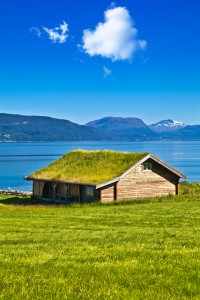Smart Roofs Could Transform California Energy and Water Use
 Installing green roofs and cool roofs in southern California could save consumers more than $211 million in energy bills and reduce emissions equivalent to removing 91,000 cars from the road each year, according to a new study from the Natural Resources Defense Council and the Emmett Center on Climate Change and the Environment at UCLA School of Law. Installing green roofs will additionally reduce stormwater runoff that pollutes our beaches.
Installing green roofs and cool roofs in southern California could save consumers more than $211 million in energy bills and reduce emissions equivalent to removing 91,000 cars from the road each year, according to a new study from the Natural Resources Defense Council and the Emmett Center on Climate Change and the Environment at UCLA School of Law. Installing green roofs will additionally reduce stormwater runoff that pollutes our beaches.“Southern California is facing a complex, and mostly worsening, set of sustainability challenges but solutions exist,” said Noah Garrison, project attorney for NRDC’s water program. “Green roofs and cool roofs are a solution that can be implemented today. Taking simple steps like installing drought resistant plants on a roof surface or painting roofs to reflect the sun’s energy can dramatically reduce our dependence on fossil fuels and, for green roofs, reduce the amount of pollution that flows to our rivers and beaches.”
According to the report, “Looking Up: How Green Roofs and Cool Roofs Can Reduce Energy Use, Address Climate Change, and Protect Water Resources in Southern California,” if green roofs or cool roofs were installed on 50 percent of existing roof surfaces for residential, commercial, and government and public use buildings in southern California, it could save up to 1.6 million megawatt hours of electricity annually, enough energy to power more than 127,000 homes in California and save residents up to $211 million in energy costs each year based on 2012 rates. The energy savings would cut carbon pollution by 465,000 metric tons annually.
Because green roofs absorb and evaporate rainfall, installing green roofs on 50 percent of the existing roof surfaces could reduce stormwater runoff by more than 36 billion gallons each year – enough to fill more than 54,000 Olympic-sized swimming pools – significantly reducing the volume of pollution reaching our local waters.
“The scale of these benefits is truly impressive, and justifies a much more aggressive set of policies and incentives to help advance the adoption of green roofs and cool roofs in our region,” said Cara Horowitz, the Andrew Sabin Family Foundation executive director of the Emmett Center on Climate Change and the Environment at UCLA School of Law. “If Los Angeles and other southern California cities provided better incentives for residential and commercial building owners to install green roofs and cool roofs, we would have healthier, more sustainable neighborhoods and save money too.”
Ensuring new development projects install green and cool roofs can also provide tremendous savings. Installing green roofs and cool roofs on 50 percent of new construction and redevelopment would save up to one million megawatt-hours per year by 2035 and $131 million in electricity costs during that time period, while cutting carbon pollution by 288,000 metric tons annually, which is the equivalent of taking more than 56,000 cars off the road each year. It would also result in a reduction of 20 billion gallons of stormwater runoff in southern California each year by 2035, significantly reducing the volume of pollution flowing to local rivers, lakes, and beaches.
Additionally, green and cool roofs can cut urban temperatures. Cities create their own heat islands—areas where surface and ambient air temperatures are higher than in surrounding undeveloped or rural land. The dark, paved surfaces in urban and suburban areas absorb and radiate heat back into the surrounding communities. These increased air temperatures worsen smog and other air pollution, and can result in increased heat-related illnesses. Installing green roofs and cool roofs across urban landscapes can help cool down neighborhoods, reducing temperatures in urban cores by as much as 3.5 degrees Fahrenheit, with air quality and human health benefits.
“Green roofs and cool roofs make sense for southern California – we have mild winters but hot summers, and these types of roof can keep buildings and entire cities cooler, saving energy and protecting water resources in the process,” said Garrison.
Background
Green roofs have a thin covering of soil and live plants growing on them which provide shade, insulation, and evaporative cooling that reduces temperatures on the roof surface and in the building interior below. The temperature of a green roof can often be cooler than the surrounding ambient air, resulting in less energy needed to cool the building interior. Conversely, the temperatures on the surface of a dark, conventional roof may exceed those of ambient air by 90°F (50°C) or more on a hot, sunny day, and much of that heat transfers into the building’s interior, requiring more energy for cooling.
Cool roofs, like green roofs, use smarter materials to reduce energy demand and lower temperatures compared with traditional rooftops. Cool roofs use reflective materials, often but not always light-colored, to reflect more of the sun’s energy than dark, traditional roofs, and to more efficiently transmit heat from the building’s interior. Compared to conventional dark roofs, the surface of a cool roof can be 50° to 60°F (28° to 33°C) cooler on a hot, sunny day.
You can return to the main Market News page, or press the Back button on your browser.

